BLO5539 - R&D Incentives & Australian Income Tax Law for Small Firms
VerifiedAdded on 2023/06/11
|9
|3751
|286
Report
AI Summary
This report provides an overview of the R&D Tax Incentive (R&DTI) in Australia, focusing on its implications for small businesses. It discusses the regulatory framework, including the Income Tax Assessment Act 1997 (ITAA97) and relevant tax rulings, highlighting the criteria for core and supporting R&D activities. The report also examines the effectiveness of these incentives in encouraging innovation and economic growth, while addressing the need for reforms to improve integrity, support small businesses, and refocus larger companies towards high-intensity R&D. The report concludes by suggesting that increasing awareness of these incentives is crucial for maximizing their potential impact on Australian businesses.
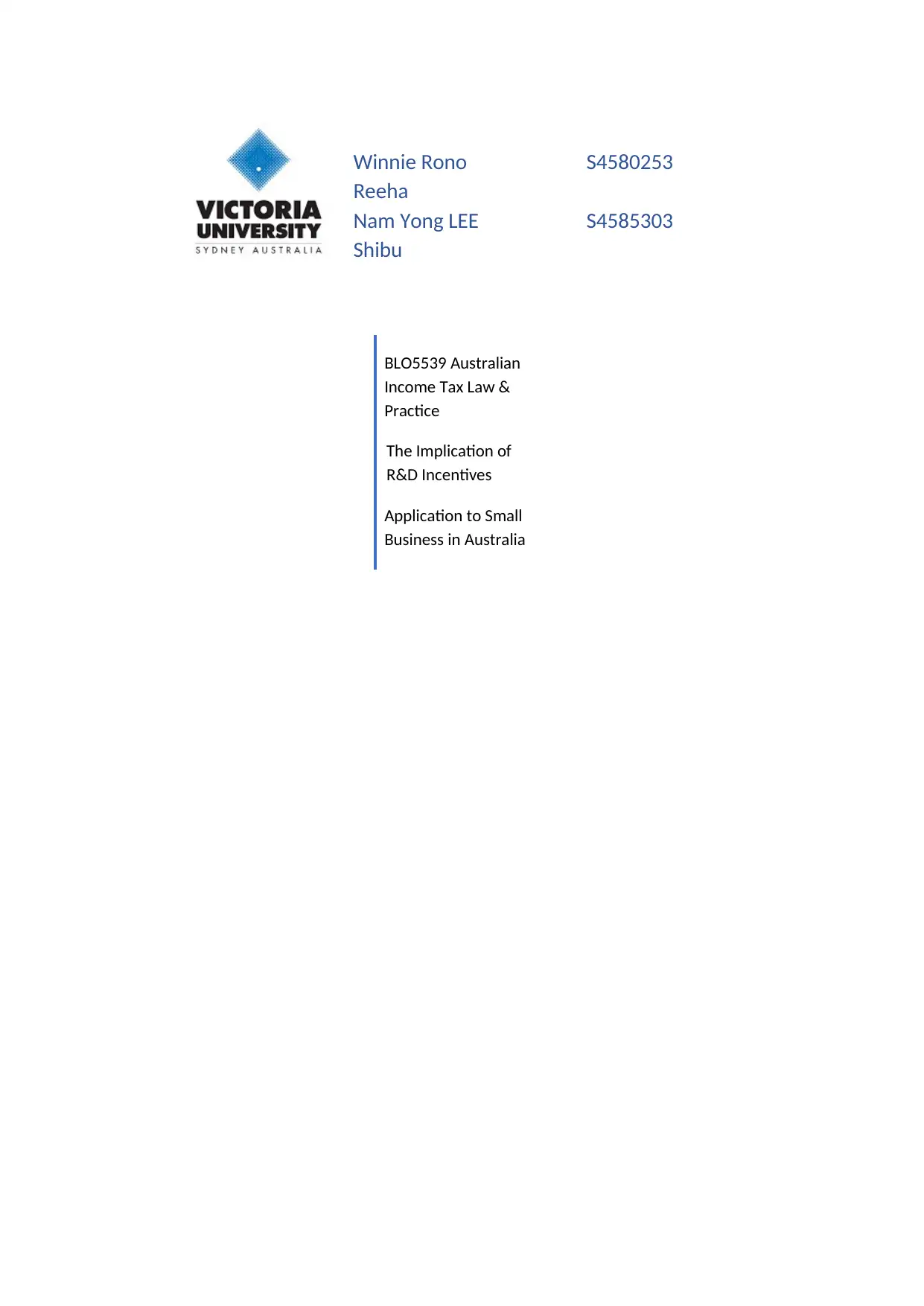
Winnie Rono S4580253
Reeha
Nam Yong LEE S4585303
Shibu
BLO5539 Australian
Income Tax Law &
Practice
The Implication of
R&D Incentives
Application to Small
Business in Australia
Reeha
Nam Yong LEE S4585303
Shibu
BLO5539 Australian
Income Tax Law &
Practice
The Implication of
R&D Incentives
Application to Small
Business in Australia
Paraphrase This Document
Need a fresh take? Get an instant paraphrase of this document with our AI Paraphraser
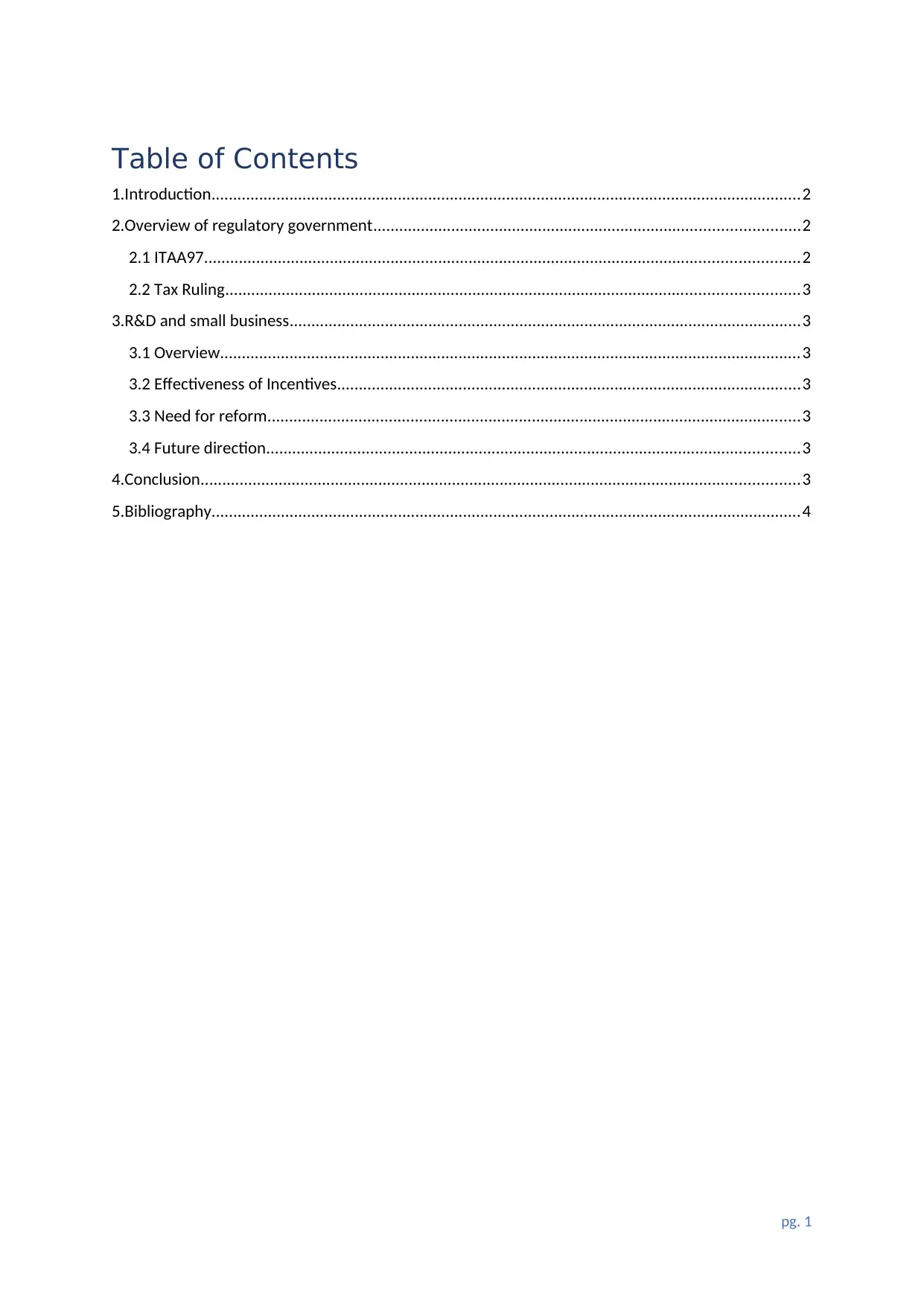
Table of Contents
1.Introduction........................................................................................................................................2
2.Overview of regulatory government..................................................................................................2
2.1 ITAA97.........................................................................................................................................2
2.2 Tax Ruling....................................................................................................................................3
3.R&D and small business......................................................................................................................3
3.1 Overview......................................................................................................................................3
3.2 Effectiveness of Incentives...........................................................................................................3
3.3 Need for reform...........................................................................................................................3
3.4 Future direction...........................................................................................................................3
4.Conclusion..........................................................................................................................................3
5.Bibliography........................................................................................................................................4
pg. 1
1.Introduction........................................................................................................................................2
2.Overview of regulatory government..................................................................................................2
2.1 ITAA97.........................................................................................................................................2
2.2 Tax Ruling....................................................................................................................................3
3.R&D and small business......................................................................................................................3
3.1 Overview......................................................................................................................................3
3.2 Effectiveness of Incentives...........................................................................................................3
3.3 Need for reform...........................................................................................................................3
3.4 Future direction...........................................................................................................................3
4.Conclusion..........................................................................................................................................3
5.Bibliography........................................................................................................................................4
pg. 1
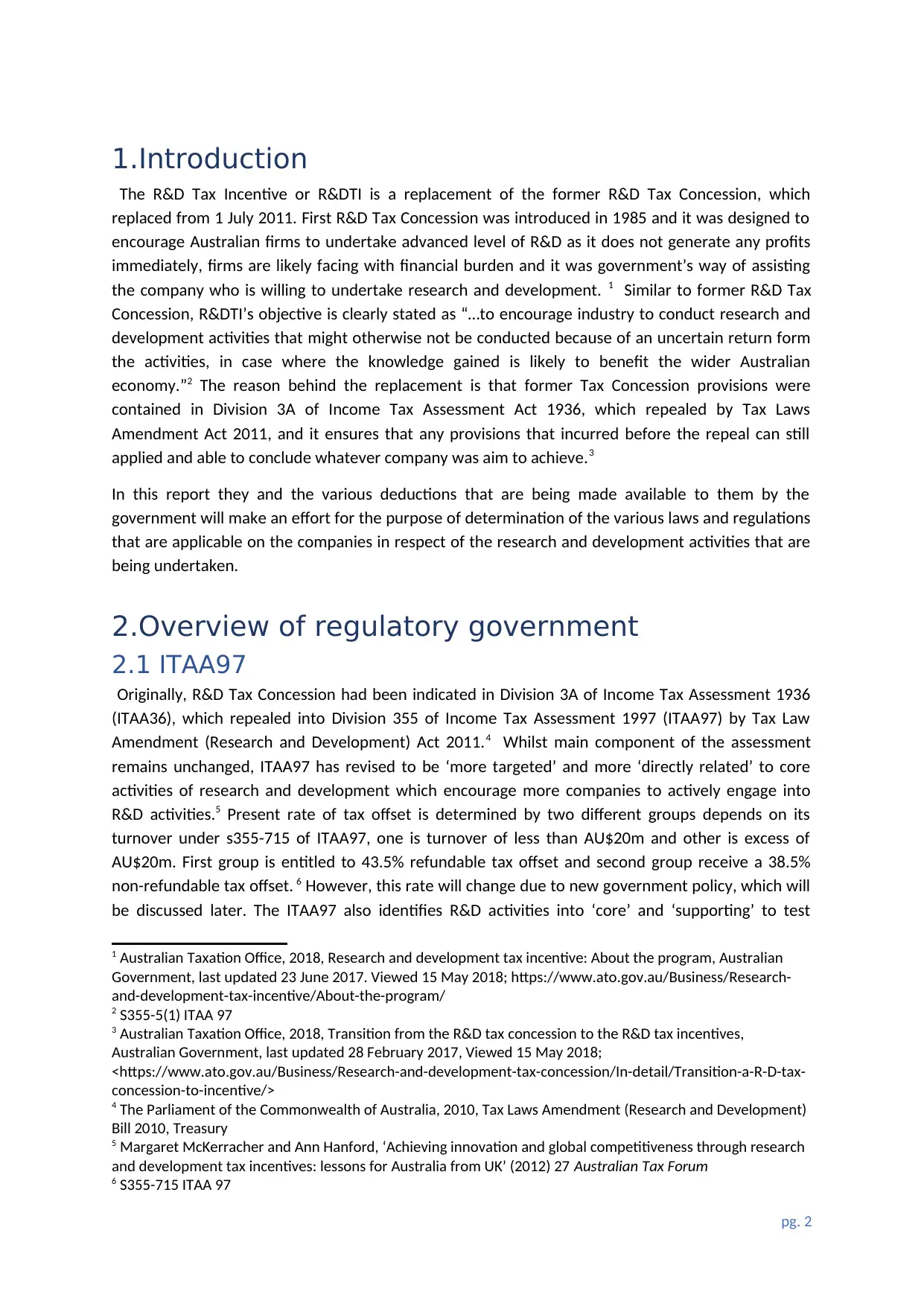
1.Introduction
The R&D Tax Incentive or R&DTI is a replacement of the former R&D Tax Concession, which
replaced from 1 July 2011. First R&D Tax Concession was introduced in 1985 and it was designed to
encourage Australian firms to undertake advanced level of R&D as it does not generate any profits
immediately, firms are likely facing with financial burden and it was government’s way of assisting
the company who is willing to undertake research and development. 1 Similar to former R&D Tax
Concession, R&DTI’s objective is clearly stated as “…to encourage industry to conduct research and
development activities that might otherwise not be conducted because of an uncertain return form
the activities, in case where the knowledge gained is likely to benefit the wider Australian
economy.”2 The reason behind the replacement is that former Tax Concession provisions were
contained in Division 3A of Income Tax Assessment Act 1936, which repealed by Tax Laws
Amendment Act 2011, and it ensures that any provisions that incurred before the repeal can still
applied and able to conclude whatever company was aim to achieve.3
In this report they and the various deductions that are being made available to them by the
government will make an effort for the purpose of determination of the various laws and regulations
that are applicable on the companies in respect of the research and development activities that are
being undertaken.
2.Overview of regulatory government
2.1 ITAA97
Originally, R&D Tax Concession had been indicated in Division 3A of Income Tax Assessment 1936
(ITAA36), which repealed into Division 355 of Income Tax Assessment 1997 (ITAA97) by Tax Law
Amendment (Research and Development) Act 2011.4 Whilst main component of the assessment
remains unchanged, ITAA97 has revised to be ‘more targeted’ and more ‘directly related’ to core
activities of research and development which encourage more companies to actively engage into
R&D activities.5 Present rate of tax offset is determined by two different groups depends on its
turnover under s355-715 of ITAA97, one is turnover of less than AU$20m and other is excess of
AU$20m. First group is entitled to 43.5% refundable tax offset and second group receive a 38.5%
non-refundable tax offset. 6 However, this rate will change due to new government policy, which will
be discussed later. The ITAA97 also identifies R&D activities into ‘core’ and ‘supporting’ to test
1 Australian Taxation Office, 2018, Research and development tax incentive: About the program, Australian
Government, last updated 23 June 2017. Viewed 15 May 2018; https://www.ato.gov.au/Business/Research-
and-development-tax-incentive/About-the-program/
2 S355-5(1) ITAA 97
3 Australian Taxation Office, 2018, Transition from the R&D tax concession to the R&D tax incentives,
Australian Government, last updated 28 February 2017, Viewed 15 May 2018;
<https://www.ato.gov.au/Business/Research-and-development-tax-concession/In-detail/Transition-a-R-D-tax-
concession-to-incentive/>
4 The Parliament of the Commonwealth of Australia, 2010, Tax Laws Amendment (Research and Development)
Bill 2010, Treasury
5 Margaret McKerracher and Ann Hanford, ‘Achieving innovation and global competitiveness through research
and development tax incentives: lessons for Australia from UK’ (2012) 27 Australian Tax Forum
6 S355-715 ITAA 97
pg. 2
The R&D Tax Incentive or R&DTI is a replacement of the former R&D Tax Concession, which
replaced from 1 July 2011. First R&D Tax Concession was introduced in 1985 and it was designed to
encourage Australian firms to undertake advanced level of R&D as it does not generate any profits
immediately, firms are likely facing with financial burden and it was government’s way of assisting
the company who is willing to undertake research and development. 1 Similar to former R&D Tax
Concession, R&DTI’s objective is clearly stated as “…to encourage industry to conduct research and
development activities that might otherwise not be conducted because of an uncertain return form
the activities, in case where the knowledge gained is likely to benefit the wider Australian
economy.”2 The reason behind the replacement is that former Tax Concession provisions were
contained in Division 3A of Income Tax Assessment Act 1936, which repealed by Tax Laws
Amendment Act 2011, and it ensures that any provisions that incurred before the repeal can still
applied and able to conclude whatever company was aim to achieve.3
In this report they and the various deductions that are being made available to them by the
government will make an effort for the purpose of determination of the various laws and regulations
that are applicable on the companies in respect of the research and development activities that are
being undertaken.
2.Overview of regulatory government
2.1 ITAA97
Originally, R&D Tax Concession had been indicated in Division 3A of Income Tax Assessment 1936
(ITAA36), which repealed into Division 355 of Income Tax Assessment 1997 (ITAA97) by Tax Law
Amendment (Research and Development) Act 2011.4 Whilst main component of the assessment
remains unchanged, ITAA97 has revised to be ‘more targeted’ and more ‘directly related’ to core
activities of research and development which encourage more companies to actively engage into
R&D activities.5 Present rate of tax offset is determined by two different groups depends on its
turnover under s355-715 of ITAA97, one is turnover of less than AU$20m and other is excess of
AU$20m. First group is entitled to 43.5% refundable tax offset and second group receive a 38.5%
non-refundable tax offset. 6 However, this rate will change due to new government policy, which will
be discussed later. The ITAA97 also identifies R&D activities into ‘core’ and ‘supporting’ to test
1 Australian Taxation Office, 2018, Research and development tax incentive: About the program, Australian
Government, last updated 23 June 2017. Viewed 15 May 2018; https://www.ato.gov.au/Business/Research-
and-development-tax-incentive/About-the-program/
2 S355-5(1) ITAA 97
3 Australian Taxation Office, 2018, Transition from the R&D tax concession to the R&D tax incentives,
Australian Government, last updated 28 February 2017, Viewed 15 May 2018;
<https://www.ato.gov.au/Business/Research-and-development-tax-concession/In-detail/Transition-a-R-D-tax-
concession-to-incentive/>
4 The Parliament of the Commonwealth of Australia, 2010, Tax Laws Amendment (Research and Development)
Bill 2010, Treasury
5 Margaret McKerracher and Ann Hanford, ‘Achieving innovation and global competitiveness through research
and development tax incentives: lessons for Australia from UK’ (2012) 27 Australian Tax Forum
6 S355-715 ITAA 97
pg. 2
⊘ This is a preview!⊘
Do you want full access?
Subscribe today to unlock all pages.

Trusted by 1+ million students worldwide
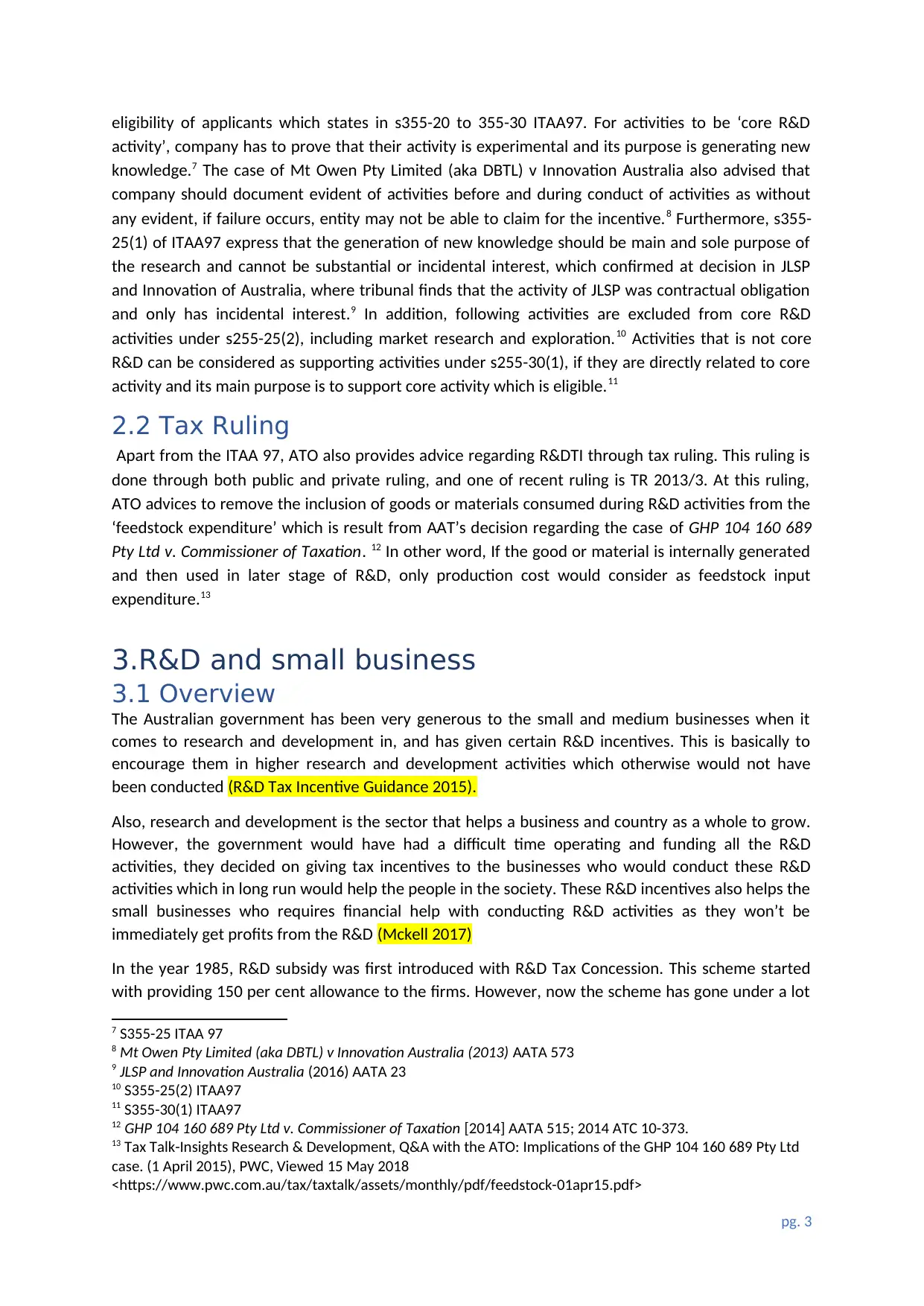
eligibility of applicants which states in s355-20 to 355-30 ITAA97. For activities to be ‘core R&D
activity’, company has to prove that their activity is experimental and its purpose is generating new
knowledge.7 The case of Mt Owen Pty Limited (aka DBTL) v Innovation Australia also advised that
company should document evident of activities before and during conduct of activities as without
any evident, if failure occurs, entity may not be able to claim for the incentive.8 Furthermore, s355-
25(1) of ITAA97 express that the generation of new knowledge should be main and sole purpose of
the research and cannot be substantial or incidental interest, which confirmed at decision in JLSP
and Innovation of Australia, where tribunal finds that the activity of JLSP was contractual obligation
and only has incidental interest.9 In addition, following activities are excluded from core R&D
activities under s255-25(2), including market research and exploration.10 Activities that is not core
R&D can be considered as supporting activities under s255-30(1), if they are directly related to core
activity and its main purpose is to support core activity which is eligible.11
2.2 Tax Ruling
Apart from the ITAA 97, ATO also provides advice regarding R&DTI through tax ruling. This ruling is
done through both public and private ruling, and one of recent ruling is TR 2013/3. At this ruling,
ATO advices to remove the inclusion of goods or materials consumed during R&D activities from the
‘feedstock expenditure’ which is result from AAT’s decision regarding the case of GHP 104 160 689
Pty Ltd v. Commissioner of Taxation. 12 In other word, If the good or material is internally generated
and then used in later stage of R&D, only production cost would consider as feedstock input
expenditure.13
3.R&D and small business
3.1 Overview
The Australian government has been very generous to the small and medium businesses when it
comes to research and development in, and has given certain R&D incentives. This is basically to
encourage them in higher research and development activities which otherwise would not have
been conducted (R&D Tax Incentive Guidance 2015).
Also, research and development is the sector that helps a business and country as a whole to grow.
However, the government would have had a difficult time operating and funding all the R&D
activities, they decided on giving tax incentives to the businesses who would conduct these R&D
activities which in long run would help the people in the society. These R&D incentives also helps the
small businesses who requires financial help with conducting R&D activities as they won’t be
immediately get profits from the R&D (Mckell 2017)
In the year 1985, R&D subsidy was first introduced with R&D Tax Concession. This scheme started
with providing 150 per cent allowance to the firms. However, now the scheme has gone under a lot
7 S355-25 ITAA 97
8 Mt Owen Pty Limited (aka DBTL) v Innovation Australia (2013) AATA 573
9 JLSP and Innovation Australia (2016) AATA 23
10 S355-25(2) ITAA97
11 S355-30(1) ITAA97
12 GHP 104 160 689 Pty Ltd v. Commissioner of Taxation [2014] AATA 515; 2014 ATC 10-373.
13 Tax Talk-Insights Research & Development, Q&A with the ATO: Implications of the GHP 104 160 689 Pty Ltd
case. (1 April 2015), PWC, Viewed 15 May 2018
<https://www.pwc.com.au/tax/taxtalk/assets/monthly/pdf/feedstock-01apr15.pdf>
pg. 3
activity’, company has to prove that their activity is experimental and its purpose is generating new
knowledge.7 The case of Mt Owen Pty Limited (aka DBTL) v Innovation Australia also advised that
company should document evident of activities before and during conduct of activities as without
any evident, if failure occurs, entity may not be able to claim for the incentive.8 Furthermore, s355-
25(1) of ITAA97 express that the generation of new knowledge should be main and sole purpose of
the research and cannot be substantial or incidental interest, which confirmed at decision in JLSP
and Innovation of Australia, where tribunal finds that the activity of JLSP was contractual obligation
and only has incidental interest.9 In addition, following activities are excluded from core R&D
activities under s255-25(2), including market research and exploration.10 Activities that is not core
R&D can be considered as supporting activities under s255-30(1), if they are directly related to core
activity and its main purpose is to support core activity which is eligible.11
2.2 Tax Ruling
Apart from the ITAA 97, ATO also provides advice regarding R&DTI through tax ruling. This ruling is
done through both public and private ruling, and one of recent ruling is TR 2013/3. At this ruling,
ATO advices to remove the inclusion of goods or materials consumed during R&D activities from the
‘feedstock expenditure’ which is result from AAT’s decision regarding the case of GHP 104 160 689
Pty Ltd v. Commissioner of Taxation. 12 In other word, If the good or material is internally generated
and then used in later stage of R&D, only production cost would consider as feedstock input
expenditure.13
3.R&D and small business
3.1 Overview
The Australian government has been very generous to the small and medium businesses when it
comes to research and development in, and has given certain R&D incentives. This is basically to
encourage them in higher research and development activities which otherwise would not have
been conducted (R&D Tax Incentive Guidance 2015).
Also, research and development is the sector that helps a business and country as a whole to grow.
However, the government would have had a difficult time operating and funding all the R&D
activities, they decided on giving tax incentives to the businesses who would conduct these R&D
activities which in long run would help the people in the society. These R&D incentives also helps the
small businesses who requires financial help with conducting R&D activities as they won’t be
immediately get profits from the R&D (Mckell 2017)
In the year 1985, R&D subsidy was first introduced with R&D Tax Concession. This scheme started
with providing 150 per cent allowance to the firms. However, now the scheme has gone under a lot
7 S355-25 ITAA 97
8 Mt Owen Pty Limited (aka DBTL) v Innovation Australia (2013) AATA 573
9 JLSP and Innovation Australia (2016) AATA 23
10 S355-25(2) ITAA97
11 S355-30(1) ITAA97
12 GHP 104 160 689 Pty Ltd v. Commissioner of Taxation [2014] AATA 515; 2014 ATC 10-373.
13 Tax Talk-Insights Research & Development, Q&A with the ATO: Implications of the GHP 104 160 689 Pty Ltd
case. (1 April 2015), PWC, Viewed 15 May 2018
<https://www.pwc.com.au/tax/taxtalk/assets/monthly/pdf/feedstock-01apr15.pdf>
pg. 3
Paraphrase This Document
Need a fresh take? Get an instant paraphrase of this document with our AI Paraphraser
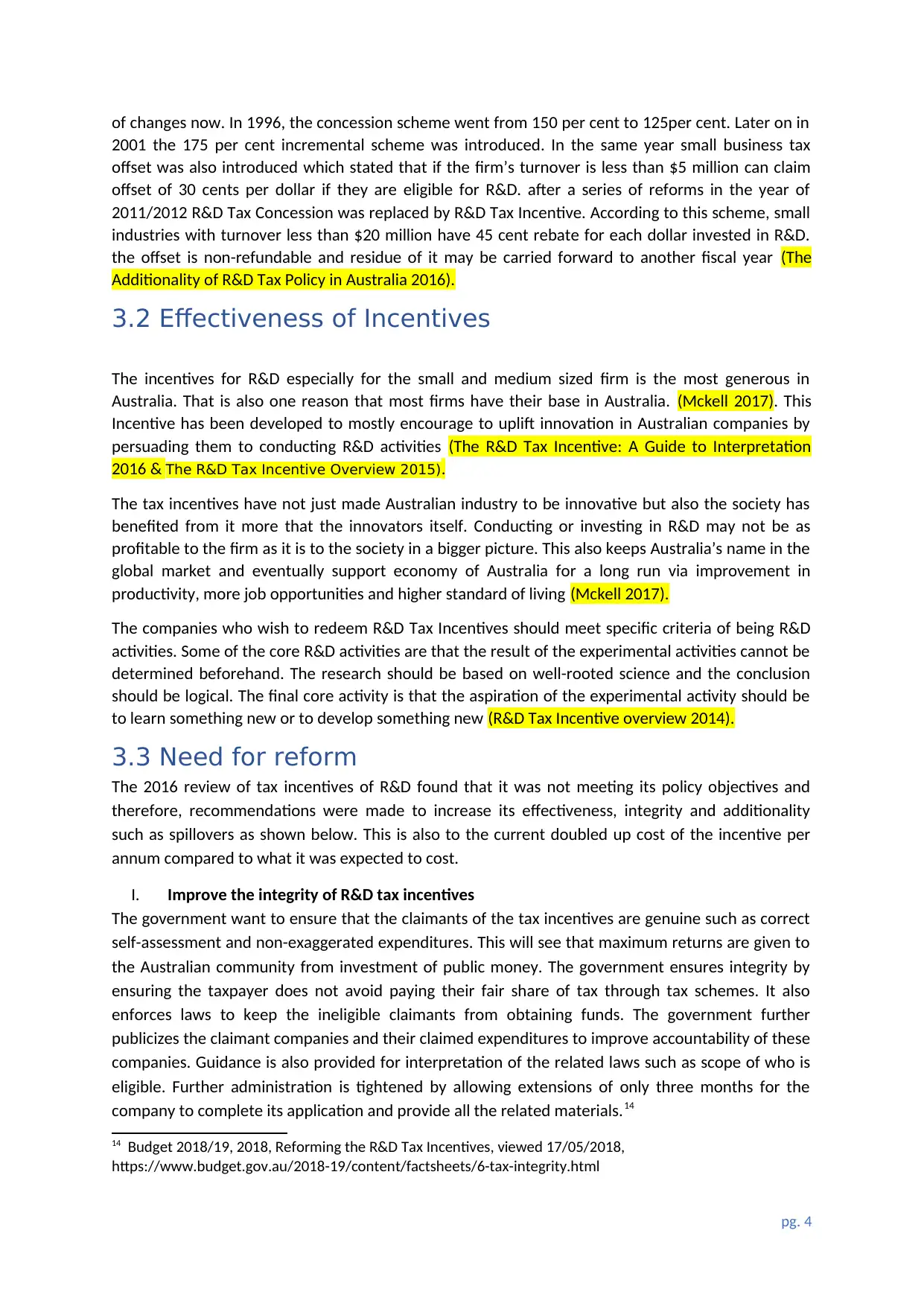
of changes now. In 1996, the concession scheme went from 150 per cent to 125per cent. Later on in
2001 the 175 per cent incremental scheme was introduced. In the same year small business tax
offset was also introduced which stated that if the firm’s turnover is less than $5 million can claim
offset of 30 cents per dollar if they are eligible for R&D. after a series of reforms in the year of
2011/2012 R&D Tax Concession was replaced by R&D Tax Incentive. According to this scheme, small
industries with turnover less than $20 million have 45 cent rebate for each dollar invested in R&D.
the offset is non-refundable and residue of it may be carried forward to another fiscal year (The
Additionality of R&D Tax Policy in Australia 2016).
3.2 Effectiveness of Incentives
The incentives for R&D especially for the small and medium sized firm is the most generous in
Australia. That is also one reason that most firms have their base in Australia. (Mckell 2017). This
Incentive has been developed to mostly encourage to uplift innovation in Australian companies by
persuading them to conducting R&D activities (The R&D Tax Incentive: A Guide to Interpretation
2016 & The R&D Tax Incentive Overview 2015).
The tax incentives have not just made Australian industry to be innovative but also the society has
benefited from it more that the innovators itself. Conducting or investing in R&D may not be as
profitable to the firm as it is to the society in a bigger picture. This also keeps Australia’s name in the
global market and eventually support economy of Australia for a long run via improvement in
productivity, more job opportunities and higher standard of living (Mckell 2017).
The companies who wish to redeem R&D Tax Incentives should meet specific criteria of being R&D
activities. Some of the core R&D activities are that the result of the experimental activities cannot be
determined beforehand. The research should be based on well-rooted science and the conclusion
should be logical. The final core activity is that the aspiration of the experimental activity should be
to learn something new or to develop something new (R&D Tax Incentive overview 2014).
3.3 Need for reform
The 2016 review of tax incentives of R&D found that it was not meeting its policy objectives and
therefore, recommendations were made to increase its effectiveness, integrity and additionality
such as spillovers as shown below. This is also to the current doubled up cost of the incentive per
annum compared to what it was expected to cost.
I. Improve the integrity of R&D tax incentives
The government want to ensure that the claimants of the tax incentives are genuine such as correct
self-assessment and non-exaggerated expenditures. This will see that maximum returns are given to
the Australian community from investment of public money. The government ensures integrity by
ensuring the taxpayer does not avoid paying their fair share of tax through tax schemes. It also
enforces laws to keep the ineligible claimants from obtaining funds. The government further
publicizes the claimant companies and their claimed expenditures to improve accountability of these
companies. Guidance is also provided for interpretation of the related laws such as scope of who is
eligible. Further administration is tightened by allowing extensions of only three months for the
company to complete its application and provide all the related materials.14
14 Budget 2018/19, 2018, Reforming the R&D Tax Incentives, viewed 17/05/2018,
https://www.budget.gov.au/2018-19/content/factsheets/6-tax-integrity.html
pg. 4
2001 the 175 per cent incremental scheme was introduced. In the same year small business tax
offset was also introduced which stated that if the firm’s turnover is less than $5 million can claim
offset of 30 cents per dollar if they are eligible for R&D. after a series of reforms in the year of
2011/2012 R&D Tax Concession was replaced by R&D Tax Incentive. According to this scheme, small
industries with turnover less than $20 million have 45 cent rebate for each dollar invested in R&D.
the offset is non-refundable and residue of it may be carried forward to another fiscal year (The
Additionality of R&D Tax Policy in Australia 2016).
3.2 Effectiveness of Incentives
The incentives for R&D especially for the small and medium sized firm is the most generous in
Australia. That is also one reason that most firms have their base in Australia. (Mckell 2017). This
Incentive has been developed to mostly encourage to uplift innovation in Australian companies by
persuading them to conducting R&D activities (The R&D Tax Incentive: A Guide to Interpretation
2016 & The R&D Tax Incentive Overview 2015).
The tax incentives have not just made Australian industry to be innovative but also the society has
benefited from it more that the innovators itself. Conducting or investing in R&D may not be as
profitable to the firm as it is to the society in a bigger picture. This also keeps Australia’s name in the
global market and eventually support economy of Australia for a long run via improvement in
productivity, more job opportunities and higher standard of living (Mckell 2017).
The companies who wish to redeem R&D Tax Incentives should meet specific criteria of being R&D
activities. Some of the core R&D activities are that the result of the experimental activities cannot be
determined beforehand. The research should be based on well-rooted science and the conclusion
should be logical. The final core activity is that the aspiration of the experimental activity should be
to learn something new or to develop something new (R&D Tax Incentive overview 2014).
3.3 Need for reform
The 2016 review of tax incentives of R&D found that it was not meeting its policy objectives and
therefore, recommendations were made to increase its effectiveness, integrity and additionality
such as spillovers as shown below. This is also to the current doubled up cost of the incentive per
annum compared to what it was expected to cost.
I. Improve the integrity of R&D tax incentives
The government want to ensure that the claimants of the tax incentives are genuine such as correct
self-assessment and non-exaggerated expenditures. This will see that maximum returns are given to
the Australian community from investment of public money. The government ensures integrity by
ensuring the taxpayer does not avoid paying their fair share of tax through tax schemes. It also
enforces laws to keep the ineligible claimants from obtaining funds. The government further
publicizes the claimant companies and their claimed expenditures to improve accountability of these
companies. Guidance is also provided for interpretation of the related laws such as scope of who is
eligible. Further administration is tightened by allowing extensions of only three months for the
company to complete its application and provide all the related materials.14
14 Budget 2018/19, 2018, Reforming the R&D Tax Incentives, viewed 17/05/2018,
https://www.budget.gov.au/2018-19/content/factsheets/6-tax-integrity.html
pg. 4
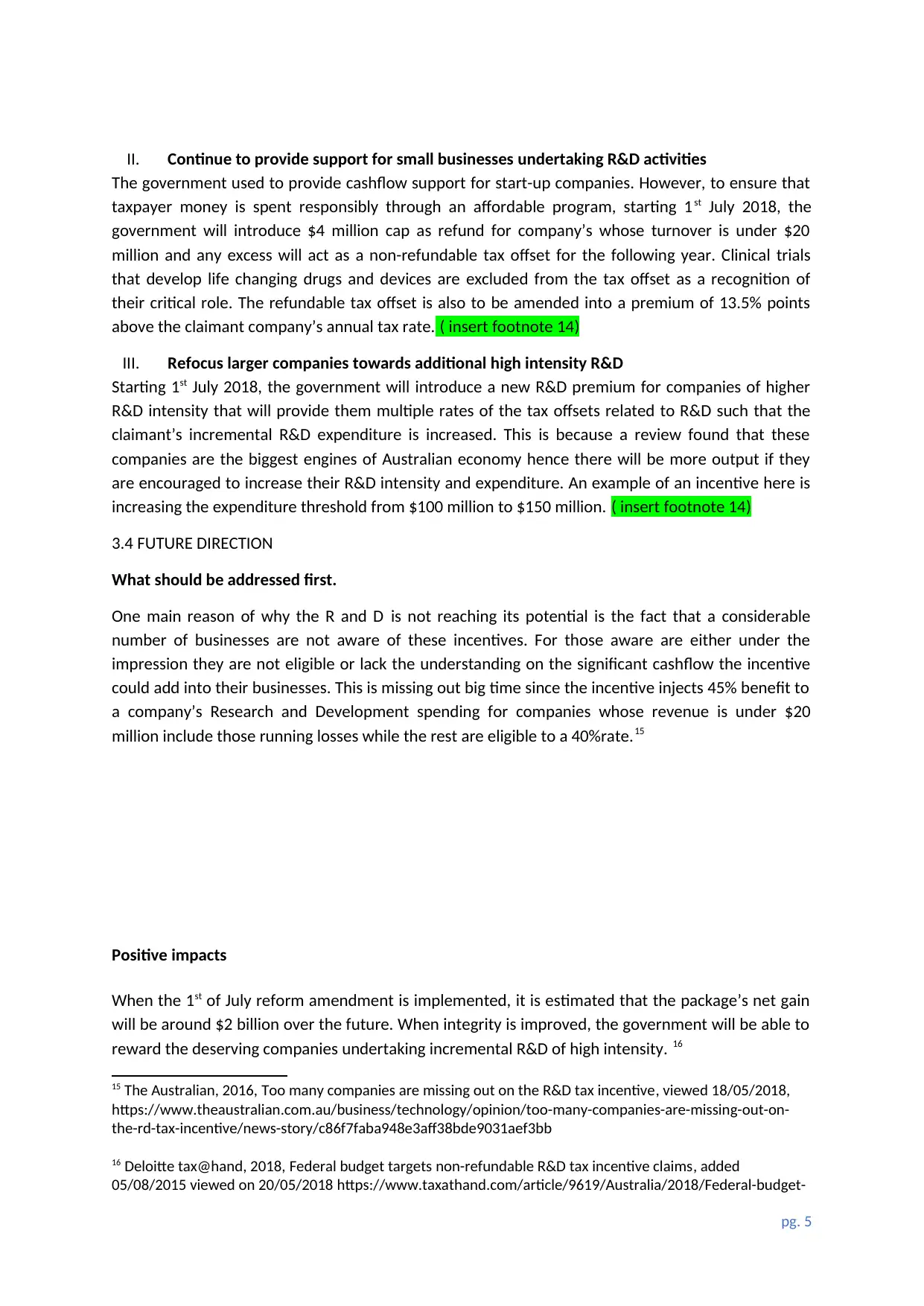
II. Continue to provide support for small businesses undertaking R&D activities
The government used to provide cashflow support for start-up companies. However, to ensure that
taxpayer money is spent responsibly through an affordable program, starting 1st July 2018, the
government will introduce $4 million cap as refund for company’s whose turnover is under $20
million and any excess will act as a non-refundable tax offset for the following year. Clinical trials
that develop life changing drugs and devices are excluded from the tax offset as a recognition of
their critical role. The refundable tax offset is also to be amended into a premium of 13.5% points
above the claimant company’s annual tax rate. ( insert footnote 14)
III. Refocus larger companies towards additional high intensity R&D
Starting 1st July 2018, the government will introduce a new R&D premium for companies of higher
R&D intensity that will provide them multiple rates of the tax offsets related to R&D such that the
claimant’s incremental R&D expenditure is increased. This is because a review found that these
companies are the biggest engines of Australian economy hence there will be more output if they
are encouraged to increase their R&D intensity and expenditure. An example of an incentive here is
increasing the expenditure threshold from $100 million to $150 million. ( insert footnote 14)
3.4 FUTURE DIRECTION
What should be addressed first.
One main reason of why the R and D is not reaching its potential is the fact that a considerable
number of businesses are not aware of these incentives. For those aware are either under the
impression they are not eligible or lack the understanding on the significant cashflow the incentive
could add into their businesses. This is missing out big time since the incentive injects 45% benefit to
a company’s Research and Development spending for companies whose revenue is under $20
million include those running losses while the rest are eligible to a 40%rate.15
Positive impacts
When the 1st of July reform amendment is implemented, it is estimated that the package’s net gain
will be around $2 billion over the future. When integrity is improved, the government will be able to
reward the deserving companies undertaking incremental R&D of high intensity. 16
15 The Australian, 2016, Too many companies are missing out on the R&D tax incentive, viewed 18/05/2018,
https://www.theaustralian.com.au/business/technology/opinion/too-many-companies-are-missing-out-on-
the-rd-tax-incentive/news-story/c86f7faba948e3aff38bde9031aef3bb
16 Deloitte tax@hand, 2018, Federal budget targets non-refundable R&D tax incentive claims, added
05/08/2015 viewed on 20/05/2018 https://www.taxathand.com/article/9619/Australia/2018/Federal-budget-
pg. 5
The government used to provide cashflow support for start-up companies. However, to ensure that
taxpayer money is spent responsibly through an affordable program, starting 1st July 2018, the
government will introduce $4 million cap as refund for company’s whose turnover is under $20
million and any excess will act as a non-refundable tax offset for the following year. Clinical trials
that develop life changing drugs and devices are excluded from the tax offset as a recognition of
their critical role. The refundable tax offset is also to be amended into a premium of 13.5% points
above the claimant company’s annual tax rate. ( insert footnote 14)
III. Refocus larger companies towards additional high intensity R&D
Starting 1st July 2018, the government will introduce a new R&D premium for companies of higher
R&D intensity that will provide them multiple rates of the tax offsets related to R&D such that the
claimant’s incremental R&D expenditure is increased. This is because a review found that these
companies are the biggest engines of Australian economy hence there will be more output if they
are encouraged to increase their R&D intensity and expenditure. An example of an incentive here is
increasing the expenditure threshold from $100 million to $150 million. ( insert footnote 14)
3.4 FUTURE DIRECTION
What should be addressed first.
One main reason of why the R and D is not reaching its potential is the fact that a considerable
number of businesses are not aware of these incentives. For those aware are either under the
impression they are not eligible or lack the understanding on the significant cashflow the incentive
could add into their businesses. This is missing out big time since the incentive injects 45% benefit to
a company’s Research and Development spending for companies whose revenue is under $20
million include those running losses while the rest are eligible to a 40%rate.15
Positive impacts
When the 1st of July reform amendment is implemented, it is estimated that the package’s net gain
will be around $2 billion over the future. When integrity is improved, the government will be able to
reward the deserving companies undertaking incremental R&D of high intensity. 16
15 The Australian, 2016, Too many companies are missing out on the R&D tax incentive, viewed 18/05/2018,
https://www.theaustralian.com.au/business/technology/opinion/too-many-companies-are-missing-out-on-
the-rd-tax-incentive/news-story/c86f7faba948e3aff38bde9031aef3bb
16 Deloitte tax@hand, 2018, Federal budget targets non-refundable R&D tax incentive claims, added
05/08/2015 viewed on 20/05/2018 https://www.taxathand.com/article/9619/Australia/2018/Federal-budget-
pg. 5
⊘ This is a preview!⊘
Do you want full access?
Subscribe today to unlock all pages.

Trusted by 1+ million students worldwide
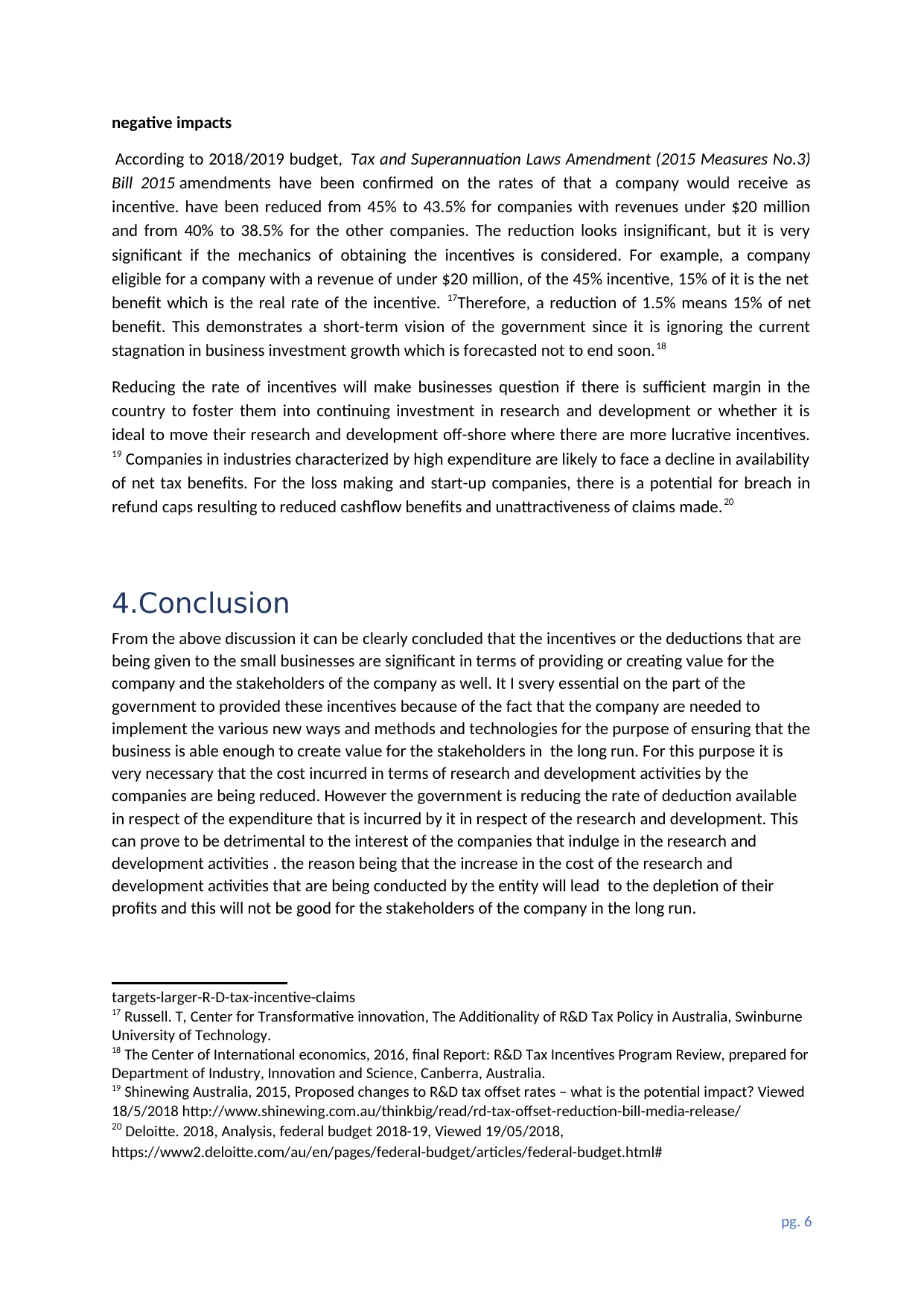
negative impacts
According to 2018/2019 budget, Tax and Superannuation Laws Amendment (2015 Measures No.3)
Bill 2015 amendments have been confirmed on the rates of that a company would receive as
incentive. have been reduced from 45% to 43.5% for companies with revenues under $20 million
and from 40% to 38.5% for the other companies. The reduction looks insignificant, but it is very
significant if the mechanics of obtaining the incentives is considered. For example, a company
eligible for a company with a revenue of under $20 million, of the 45% incentive, 15% of it is the net
benefit which is the real rate of the incentive. 17Therefore, a reduction of 1.5% means 15% of net
benefit. This demonstrates a short-term vision of the government since it is ignoring the current
stagnation in business investment growth which is forecasted not to end soon.18
Reducing the rate of incentives will make businesses question if there is sufficient margin in the
country to foster them into continuing investment in research and development or whether it is
ideal to move their research and development off-shore where there are more lucrative incentives.
19 Companies in industries characterized by high expenditure are likely to face a decline in availability
of net tax benefits. For the loss making and start-up companies, there is a potential for breach in
refund caps resulting to reduced cashflow benefits and unattractiveness of claims made.20
4.Conclusion
From the above discussion it can be clearly concluded that the incentives or the deductions that are
being given to the small businesses are significant in terms of providing or creating value for the
company and the stakeholders of the company as well. It I svery essential on the part of the
government to provided these incentives because of the fact that the company are needed to
implement the various new ways and methods and technologies for the purpose of ensuring that the
business is able enough to create value for the stakeholders in the long run. For this purpose it is
very necessary that the cost incurred in terms of research and development activities by the
companies are being reduced. However the government is reducing the rate of deduction available
in respect of the expenditure that is incurred by it in respect of the research and development. This
can prove to be detrimental to the interest of the companies that indulge in the research and
development activities . the reason being that the increase in the cost of the research and
development activities that are being conducted by the entity will lead to the depletion of their
profits and this will not be good for the stakeholders of the company in the long run.
targets-larger-R-D-tax-incentive-claims
17 Russell. T, Center for Transformative innovation, The Additionality of R&D Tax Policy in Australia, Swinburne
University of Technology.
18 The Center of International economics, 2016, final Report: R&D Tax Incentives Program Review, prepared for
Department of Industry, Innovation and Science, Canberra, Australia.
19 Shinewing Australia, 2015, Proposed changes to R&D tax offset rates – what is the potential impact? Viewed
18/5/2018 http://www.shinewing.com.au/thinkbig/read/rd-tax-offset-reduction-bill-media-release/
20 Deloitte. 2018, Analysis, federal budget 2018-19, Viewed 19/05/2018,
https://www2.deloitte.com/au/en/pages/federal-budget/articles/federal-budget.html#
pg. 6
According to 2018/2019 budget, Tax and Superannuation Laws Amendment (2015 Measures No.3)
Bill 2015 amendments have been confirmed on the rates of that a company would receive as
incentive. have been reduced from 45% to 43.5% for companies with revenues under $20 million
and from 40% to 38.5% for the other companies. The reduction looks insignificant, but it is very
significant if the mechanics of obtaining the incentives is considered. For example, a company
eligible for a company with a revenue of under $20 million, of the 45% incentive, 15% of it is the net
benefit which is the real rate of the incentive. 17Therefore, a reduction of 1.5% means 15% of net
benefit. This demonstrates a short-term vision of the government since it is ignoring the current
stagnation in business investment growth which is forecasted not to end soon.18
Reducing the rate of incentives will make businesses question if there is sufficient margin in the
country to foster them into continuing investment in research and development or whether it is
ideal to move their research and development off-shore where there are more lucrative incentives.
19 Companies in industries characterized by high expenditure are likely to face a decline in availability
of net tax benefits. For the loss making and start-up companies, there is a potential for breach in
refund caps resulting to reduced cashflow benefits and unattractiveness of claims made.20
4.Conclusion
From the above discussion it can be clearly concluded that the incentives or the deductions that are
being given to the small businesses are significant in terms of providing or creating value for the
company and the stakeholders of the company as well. It I svery essential on the part of the
government to provided these incentives because of the fact that the company are needed to
implement the various new ways and methods and technologies for the purpose of ensuring that the
business is able enough to create value for the stakeholders in the long run. For this purpose it is
very necessary that the cost incurred in terms of research and development activities by the
companies are being reduced. However the government is reducing the rate of deduction available
in respect of the expenditure that is incurred by it in respect of the research and development. This
can prove to be detrimental to the interest of the companies that indulge in the research and
development activities . the reason being that the increase in the cost of the research and
development activities that are being conducted by the entity will lead to the depletion of their
profits and this will not be good for the stakeholders of the company in the long run.
targets-larger-R-D-tax-incentive-claims
17 Russell. T, Center for Transformative innovation, The Additionality of R&D Tax Policy in Australia, Swinburne
University of Technology.
18 The Center of International economics, 2016, final Report: R&D Tax Incentives Program Review, prepared for
Department of Industry, Innovation and Science, Canberra, Australia.
19 Shinewing Australia, 2015, Proposed changes to R&D tax offset rates – what is the potential impact? Viewed
18/5/2018 http://www.shinewing.com.au/thinkbig/read/rd-tax-offset-reduction-bill-media-release/
20 Deloitte. 2018, Analysis, federal budget 2018-19, Viewed 19/05/2018,
https://www2.deloitte.com/au/en/pages/federal-budget/articles/federal-budget.html#
pg. 6
Paraphrase This Document
Need a fresh take? Get an instant paraphrase of this document with our AI Paraphraser
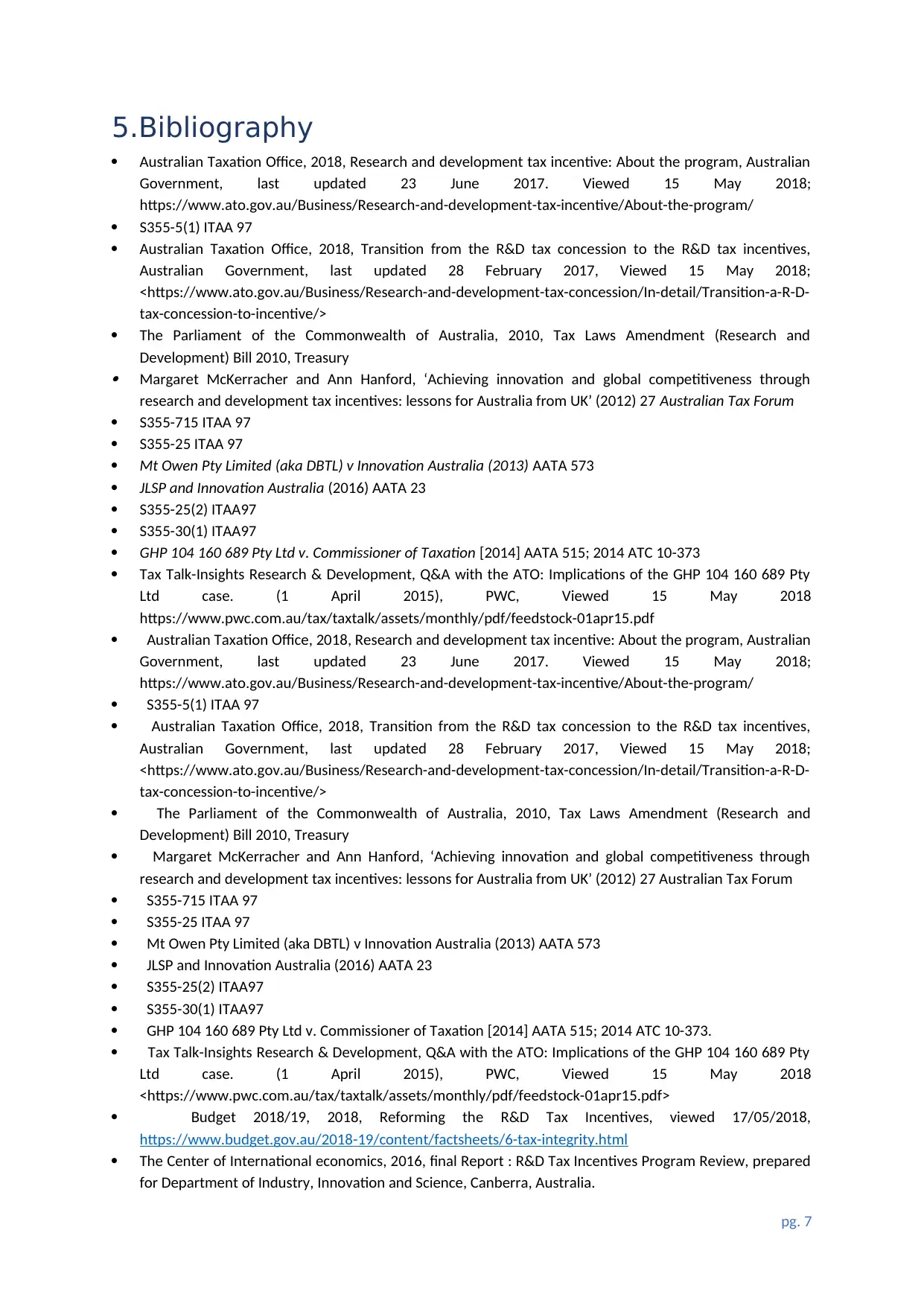
5.Bibliography
Australian Taxation Office, 2018, Research and development tax incentive: About the program, Australian
Government, last updated 23 June 2017. Viewed 15 May 2018;
https://www.ato.gov.au/Business/Research-and-development-tax-incentive/About-the-program/
S355-5(1) ITAA 97
Australian Taxation Office, 2018, Transition from the R&D tax concession to the R&D tax incentives,
Australian Government, last updated 28 February 2017, Viewed 15 May 2018;
<https://www.ato.gov.au/Business/Research-and-development-tax-concession/In-detail/Transition-a-R-D-
tax-concession-to-incentive/>
The Parliament of the Commonwealth of Australia, 2010, Tax Laws Amendment (Research and
Development) Bill 2010, Treasury
Margaret McKerracher and Ann Hanford, ‘Achieving innovation and global competitiveness through
research and development tax incentives: lessons for Australia from UK’ (2012) 27 Australian Tax Forum
S355-715 ITAA 97
S355-25 ITAA 97
Mt Owen Pty Limited (aka DBTL) v Innovation Australia (2013) AATA 573
JLSP and Innovation Australia (2016) AATA 23
S355-25(2) ITAA97
S355-30(1) ITAA97
GHP 104 160 689 Pty Ltd v. Commissioner of Taxation [2014] AATA 515; 2014 ATC 10-373
Tax Talk-Insights Research & Development, Q&A with the ATO: Implications of the GHP 104 160 689 Pty
Ltd case. (1 April 2015), PWC, Viewed 15 May 2018
https://www.pwc.com.au/tax/taxtalk/assets/monthly/pdf/feedstock-01apr15.pdf
Australian Taxation Office, 2018, Research and development tax incentive: About the program, Australian
Government, last updated 23 June 2017. Viewed 15 May 2018;
https://www.ato.gov.au/Business/Research-and-development-tax-incentive/About-the-program/
S355-5(1) ITAA 97
Australian Taxation Office, 2018, Transition from the R&D tax concession to the R&D tax incentives,
Australian Government, last updated 28 February 2017, Viewed 15 May 2018;
<https://www.ato.gov.au/Business/Research-and-development-tax-concession/In-detail/Transition-a-R-D-
tax-concession-to-incentive/>
The Parliament of the Commonwealth of Australia, 2010, Tax Laws Amendment (Research and
Development) Bill 2010, Treasury
Margaret McKerracher and Ann Hanford, ‘Achieving innovation and global competitiveness through
research and development tax incentives: lessons for Australia from UK’ (2012) 27 Australian Tax Forum
S355-715 ITAA 97
S355-25 ITAA 97
Mt Owen Pty Limited (aka DBTL) v Innovation Australia (2013) AATA 573
JLSP and Innovation Australia (2016) AATA 23
S355-25(2) ITAA97
S355-30(1) ITAA97
GHP 104 160 689 Pty Ltd v. Commissioner of Taxation [2014] AATA 515; 2014 ATC 10-373.
Tax Talk-Insights Research & Development, Q&A with the ATO: Implications of the GHP 104 160 689 Pty
Ltd case. (1 April 2015), PWC, Viewed 15 May 2018
<https://www.pwc.com.au/tax/taxtalk/assets/monthly/pdf/feedstock-01apr15.pdf>
Budget 2018/19, 2018, Reforming the R&D Tax Incentives, viewed 17/05/2018,
https://www.budget.gov.au/2018-19/content/factsheets/6-tax-integrity.html
The Center of International economics, 2016, final Report : R&D Tax Incentives Program Review, prepared
for Department of Industry, Innovation and Science, Canberra, Australia.
pg. 7
Australian Taxation Office, 2018, Research and development tax incentive: About the program, Australian
Government, last updated 23 June 2017. Viewed 15 May 2018;
https://www.ato.gov.au/Business/Research-and-development-tax-incentive/About-the-program/
S355-5(1) ITAA 97
Australian Taxation Office, 2018, Transition from the R&D tax concession to the R&D tax incentives,
Australian Government, last updated 28 February 2017, Viewed 15 May 2018;
<https://www.ato.gov.au/Business/Research-and-development-tax-concession/In-detail/Transition-a-R-D-
tax-concession-to-incentive/>
The Parliament of the Commonwealth of Australia, 2010, Tax Laws Amendment (Research and
Development) Bill 2010, Treasury
Margaret McKerracher and Ann Hanford, ‘Achieving innovation and global competitiveness through
research and development tax incentives: lessons for Australia from UK’ (2012) 27 Australian Tax Forum
S355-715 ITAA 97
S355-25 ITAA 97
Mt Owen Pty Limited (aka DBTL) v Innovation Australia (2013) AATA 573
JLSP and Innovation Australia (2016) AATA 23
S355-25(2) ITAA97
S355-30(1) ITAA97
GHP 104 160 689 Pty Ltd v. Commissioner of Taxation [2014] AATA 515; 2014 ATC 10-373
Tax Talk-Insights Research & Development, Q&A with the ATO: Implications of the GHP 104 160 689 Pty
Ltd case. (1 April 2015), PWC, Viewed 15 May 2018
https://www.pwc.com.au/tax/taxtalk/assets/monthly/pdf/feedstock-01apr15.pdf
Australian Taxation Office, 2018, Research and development tax incentive: About the program, Australian
Government, last updated 23 June 2017. Viewed 15 May 2018;
https://www.ato.gov.au/Business/Research-and-development-tax-incentive/About-the-program/
S355-5(1) ITAA 97
Australian Taxation Office, 2018, Transition from the R&D tax concession to the R&D tax incentives,
Australian Government, last updated 28 February 2017, Viewed 15 May 2018;
<https://www.ato.gov.au/Business/Research-and-development-tax-concession/In-detail/Transition-a-R-D-
tax-concession-to-incentive/>
The Parliament of the Commonwealth of Australia, 2010, Tax Laws Amendment (Research and
Development) Bill 2010, Treasury
Margaret McKerracher and Ann Hanford, ‘Achieving innovation and global competitiveness through
research and development tax incentives: lessons for Australia from UK’ (2012) 27 Australian Tax Forum
S355-715 ITAA 97
S355-25 ITAA 97
Mt Owen Pty Limited (aka DBTL) v Innovation Australia (2013) AATA 573
JLSP and Innovation Australia (2016) AATA 23
S355-25(2) ITAA97
S355-30(1) ITAA97
GHP 104 160 689 Pty Ltd v. Commissioner of Taxation [2014] AATA 515; 2014 ATC 10-373.
Tax Talk-Insights Research & Development, Q&A with the ATO: Implications of the GHP 104 160 689 Pty
Ltd case. (1 April 2015), PWC, Viewed 15 May 2018
<https://www.pwc.com.au/tax/taxtalk/assets/monthly/pdf/feedstock-01apr15.pdf>
Budget 2018/19, 2018, Reforming the R&D Tax Incentives, viewed 17/05/2018,
https://www.budget.gov.au/2018-19/content/factsheets/6-tax-integrity.html
The Center of International economics, 2016, final Report : R&D Tax Incentives Program Review, prepared
for Department of Industry, Innovation and Science, Canberra, Australia.
pg. 7
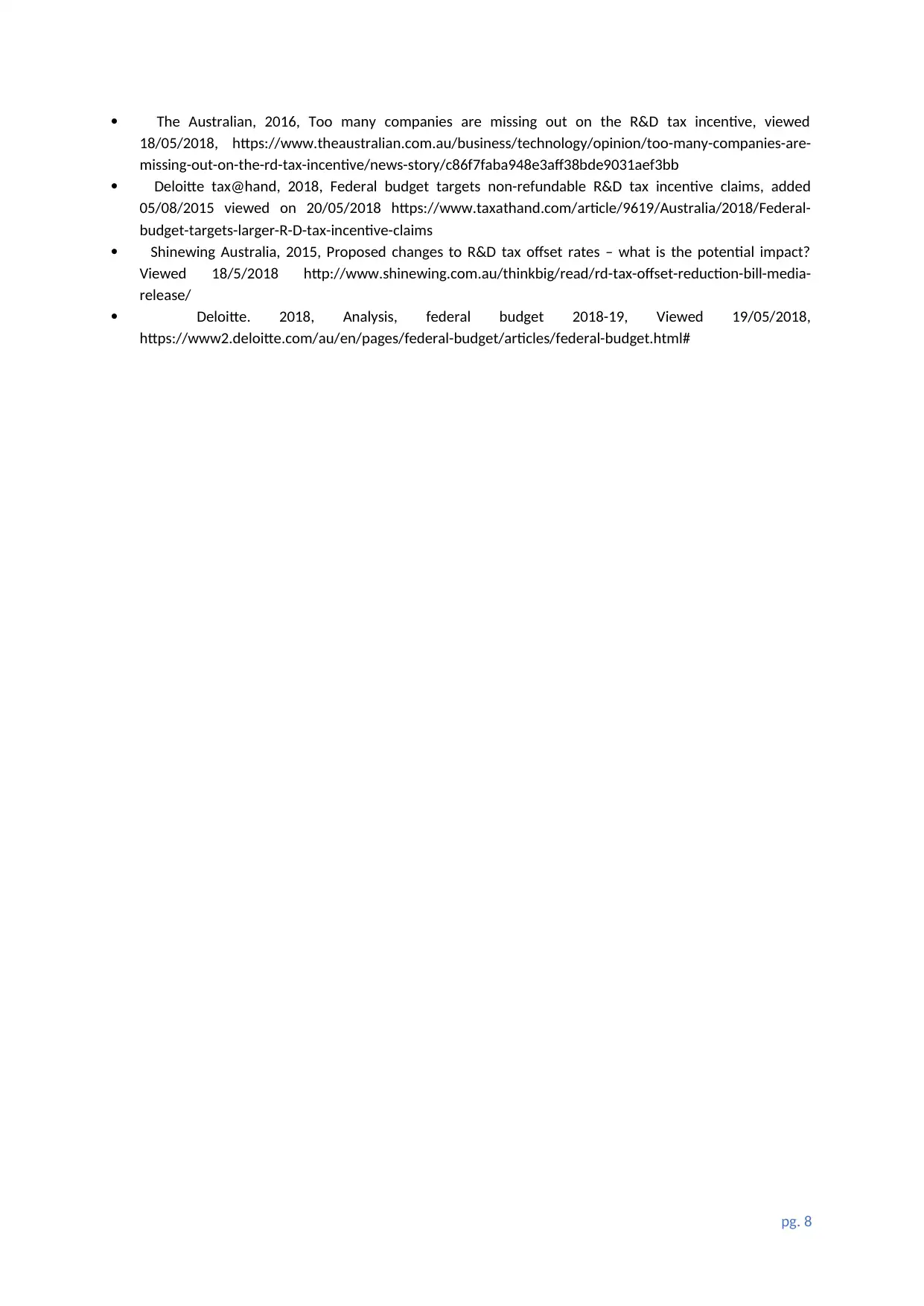
The Australian, 2016, Too many companies are missing out on the R&D tax incentive, viewed
18/05/2018, https://www.theaustralian.com.au/business/technology/opinion/too-many-companies-are-
missing-out-on-the-rd-tax-incentive/news-story/c86f7faba948e3aff38bde9031aef3bb
Deloitte tax@hand, 2018, Federal budget targets non-refundable R&D tax incentive claims, added
05/08/2015 viewed on 20/05/2018 https://www.taxathand.com/article/9619/Australia/2018/Federal-
budget-targets-larger-R-D-tax-incentive-claims
Shinewing Australia, 2015, Proposed changes to R&D tax offset rates – what is the potential impact?
Viewed 18/5/2018 http://www.shinewing.com.au/thinkbig/read/rd-tax-offset-reduction-bill-media-
release/
Deloitte. 2018, Analysis, federal budget 2018-19, Viewed 19/05/2018,
https://www2.deloitte.com/au/en/pages/federal-budget/articles/federal-budget.html#
pg. 8
18/05/2018, https://www.theaustralian.com.au/business/technology/opinion/too-many-companies-are-
missing-out-on-the-rd-tax-incentive/news-story/c86f7faba948e3aff38bde9031aef3bb
Deloitte tax@hand, 2018, Federal budget targets non-refundable R&D tax incentive claims, added
05/08/2015 viewed on 20/05/2018 https://www.taxathand.com/article/9619/Australia/2018/Federal-
budget-targets-larger-R-D-tax-incentive-claims
Shinewing Australia, 2015, Proposed changes to R&D tax offset rates – what is the potential impact?
Viewed 18/5/2018 http://www.shinewing.com.au/thinkbig/read/rd-tax-offset-reduction-bill-media-
release/
Deloitte. 2018, Analysis, federal budget 2018-19, Viewed 19/05/2018,
https://www2.deloitte.com/au/en/pages/federal-budget/articles/federal-budget.html#
pg. 8
⊘ This is a preview!⊘
Do you want full access?
Subscribe today to unlock all pages.

Trusted by 1+ million students worldwide
1 out of 9
Your All-in-One AI-Powered Toolkit for Academic Success.
+13062052269
info@desklib.com
Available 24*7 on WhatsApp / Email
![[object Object]](/_next/static/media/star-bottom.7253800d.svg)
Unlock your academic potential
Copyright © 2020–2025 A2Z Services. All Rights Reserved. Developed and managed by ZUCOL.
